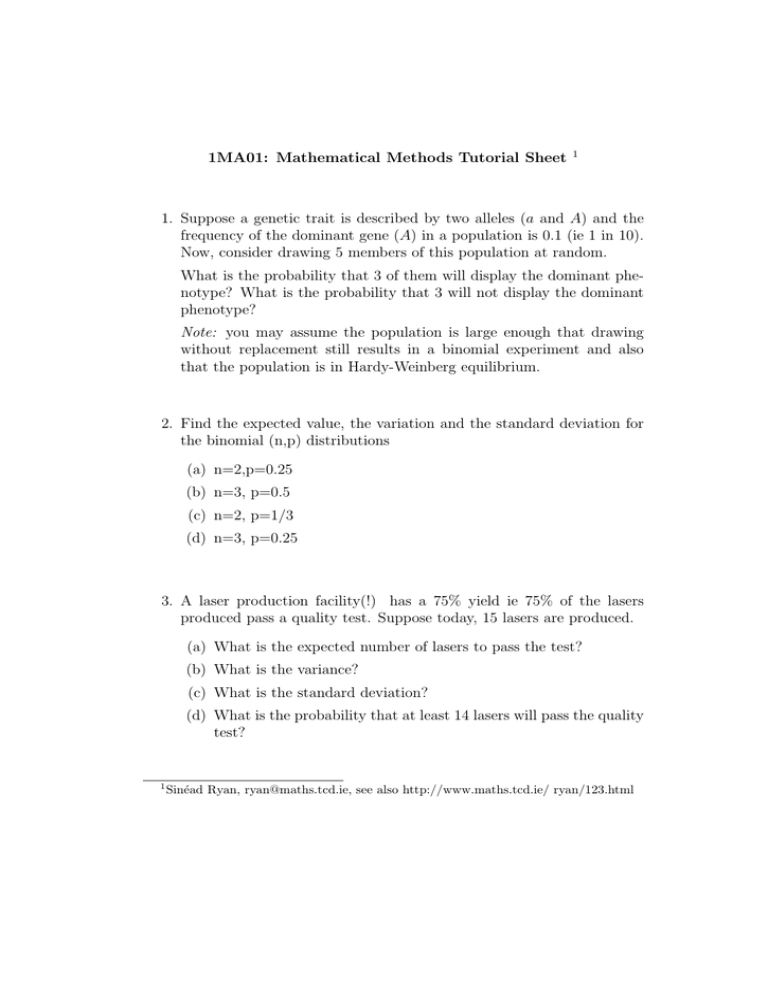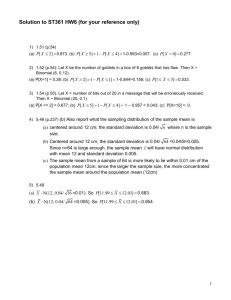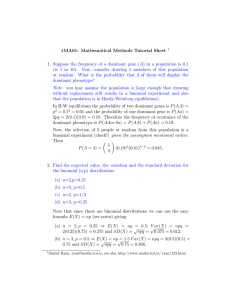1MA01: Mathematical Methods Tutorial Sheet
advertisement

1MA01: Mathematical Methods Tutorial Sheet 1 1. Suppose a genetic trait is described by two alleles (a and A) and the frequency of the dominant gene (A) in a population is 0.1 (ie 1 in 10). Now, consider drawing 5 members of this population at random. What is the probability that 3 of them will display the dominant phenotype? What is the probability that 3 will not display the dominant phenotype? Note: you may assume the population is large enough that drawing without replacement still results in a binomial experiment and also that the population is in Hardy-Weinberg equilibrium. 2. Find the expected value, the variation and the standard deviation for the binomial (n,p) distributions (a) n=2,p=0.25 (b) n=3, p=0.5 (c) n=2, p=1/3 (d) n=3, p=0.25 3. A laser production facility(!) has a 75% yield ie 75% of the lasers produced pass a quality test. Suppose today, 15 lasers are produced. (a) What is the expected number of lasers to pass the test? (b) What is the variance? (c) What is the standard deviation? (d) What is the probability that at least 14 lasers will pass the quality test? 1 Sinéad Ryan, ryan@maths.tcd.ie, see also http://www.maths.tcd.ie/ ryan/123.html 4. Sites in a nature reserve are given a habitat complexity score, evaluating their fitness as habitats for ground-dwelling animals. Let X be the habitat complexity score of a randomly chosen site. The scores can range from 0 for uninhabitable to 12 for ideal. X can be modelled by a binomial distribution. Immediately after a fire, p=0.346. E(X), and standard deviation. Determine the expected value, Eighteen years after the fire, p = 0.638. Find E(X) and the standard deviation. Verify that any two of the three definitions for E(X) and the standard deviation lead to the same results. 5. Consider a data sent via a communications channel. Bits (of data) are sent in packets of 12. The probability of a bit being corrupted over the channel is 0.15 and these errors are independent. What is the probability that no more than 2 bits in a packet are corrupted? If 6 packets are sent over the same channel, what is the probability that at least 1 packet will contain 3 or more corrupted bits? Let X be the number of packets containing 3 or more corrupted bits. What is the probability that X exceeds its mean by more than 2 standard deviations?






